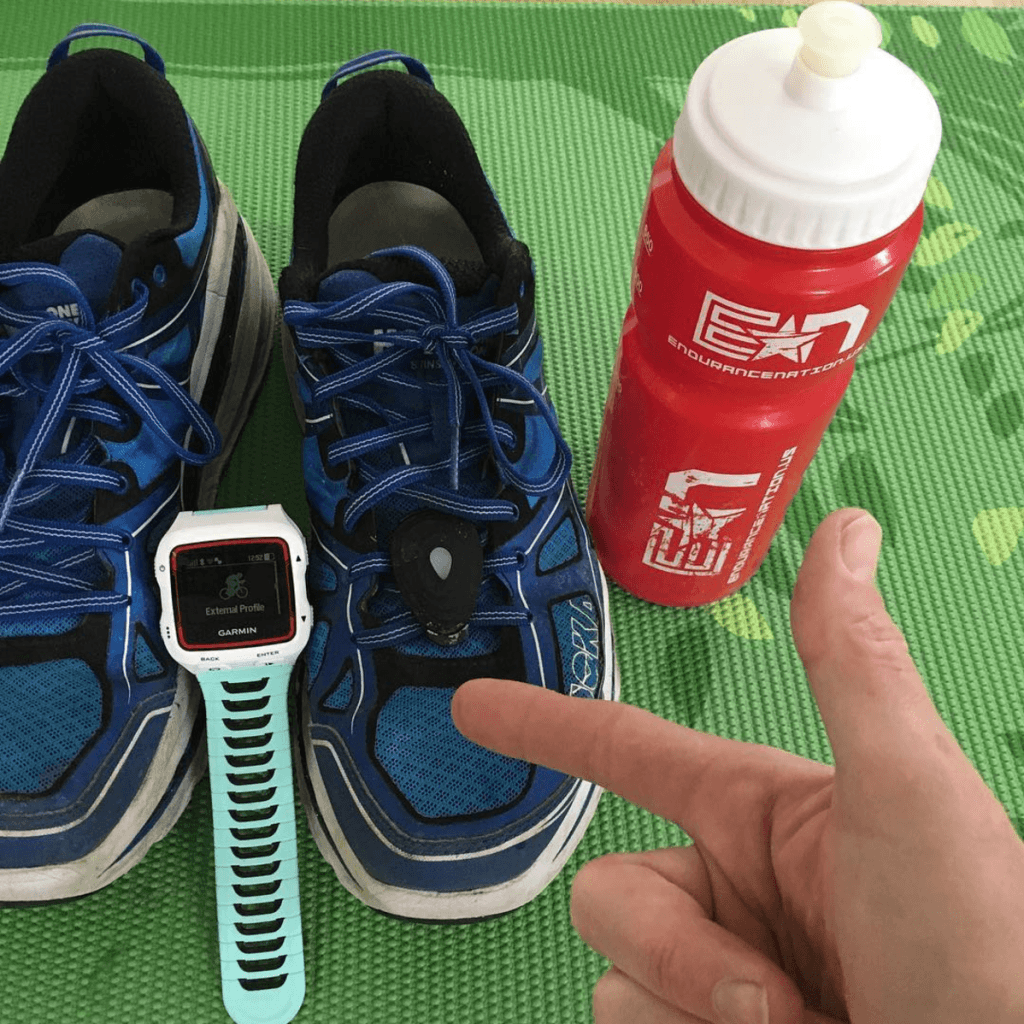 Overview
Overview
One of the biggest new pieces of gear on the running market is the smallest thing you could imagine. About the size of a quarter, and even lighter, running power meters will transform how endurance athletes train and race. The only question is, how soon are you going to join the revolution?
Like any new technology, we’re only beginning to understand the information it captures and how to use it to improve. In this article I’ll cover how to start with running with power.
If I miss anything, or you have input on something I haven’t covered, please put it in the comments below! I appreciate your help…
Giving Credit
I train with a Stryd power meter (www.stryd.com), one of our many Endurance Nation sponsors, and have discussed it in detail with the other members of EN. That said, the vast majority of what I have learned about running with power is directly due to the incredible book “Run with Power” by Jim Vance (Amazon) – he does a fantastic job of covering every conceivable aspect of running with power. If you are truly looking to become a master, I strongly suggest you purchase and dive into his book.
What This Post Won’t Cover
The goal here is to get you up to speed on power as quickly as possible, and point you towards the most relevant areas for your improvement. It is by no means comprehensive (again, see Run with Power by Jim Vance), but it’s meant to be easy to understand and effective. You don’t need do know everything about a power meter to use it effectively, just like you don’t know everything about your car – it just gets you places.
In addition, this article won’t cover…
- Evaluating a single workout;
- Explaining the science behind every metric;
- Key workouts for each race type;
- Sample training plans, etc.
Finally, understand that as running with power evolves, some segments of this resource may become out of date. We’ll do our best to keep it updated, but if we’ve missed something please let us know in the comments or on our Facebook page .
Why Power, Why Now?
“This is such a new technology, why should I use it now?
Precisely! This is actually the second generation of running power meters, and the technology has significantly improved. While Moore’s Law dictates that they will continue to get better and cheaper, these devices are now officially affordable and effective.
The device is nothing more than a means of capturing your run performance. The sooner you start capturing it, the more data you will have. The more data you have, the more informed decisions you can make moving forward. Know thyself!
If you wait until the week before your race to make this purchase, the only thing you’ll be able to do with it is just capturing what you’re doing. Having a power meter in training is the equivalent of conducting a research project on yourself.
Before power meters we used to track distance, time and heart rate — all outcomes. Thanks to the advent of technology, power meters allow us to see the work that you’re putting IN. By taking one step closer to the source, we can better understand how hard you are training, the effective of that training, and where your training can be improved.
Current State of Run Powermeters: Spring 2017
All of this was written in March 2017, so if you’re using the Internet time machine looking backwards, yes, I am sure things are very different for you now!
From a device level, run power meters like Stryd are 100% consumer-friendly and ready to use.
Data can be captured and analyzed, giving an excellent post-run perspective on what you Just ran – from speed to effort to leg strength and much more. Using that data, you can infer Exactly what you should run next. This is the area that leading coaches are exploring to give their athletes an edge.
The big gap is real-time application of run data to inform you while you are training and racing.
This is as much a technology gap as it is a cognitive one. The rapidly evolving technology is trying so solve the problem of getting that data to the end user via their watch. The folks as Stryd are using Garmin’s platform to extend their functionality, only recently giving users the chance to see a “rolling average” of power on their watch (vs the very jumpy actual power) OR they can get a auto-lap Average Power.
Soon, we’ll have all of that at once! It will be just like riding with power with a full heads up display.
Cognitively speaking, it’s really hard as a runner for 20+ years to push aside your pace-based style for running with Power. I am juggling pace zones and wattage zones, while effectively reviewing my desired outcomes. It’s tough, but I am confident I’ll emerge on the other side a better, more efficient runner.
Technology Coach Patrick Uses for Running with Power
- Stryd Power Meter – www.stryd.com
- Garmin Forerunner 920XT – www.garmin.com
- Training Peaks, Premium Edition – www.trainingpeaks.com
How I Set It Up:
Step 1. Purchase and Activate Stryd Power Meter. No rocket science here, once you get it open, charge it up and then pair via Bluetooth to your smartphone. You’ll likely be prompted to download / install a software update; this happens over Bluetooth so click yes and wait a minute.
You will use this app to download run workouts to Stryd’s PowerCenter as well as to view battery life, configure your profile information and more. You can use your phone as the “run device” to capture information when you head out, useful if you don’t have a good compatible watch.
Note, if you want to upload to the Stryd Powercenter, you need to use the iPhone/Smartphone App to connect with your deviced and upload it. Once uploaded, the run no longer lives on your device, but on the web.
Calibrating Your Stryd – Most powermeters require some form of calibration, but the Stryd was designed to be bulletproof! No calibration is required: http://stryd.com
Step 2. Configure Your Garmin Forerunner 920XT. The first part is just making sure that your PM and your Garmin can connect via Bluetooth. Initially this needed to be done as another “bike” but as of January 2017, it can now display power while I am in run mode (next to other run metrics). Once it’s paired, you are 50% there.
The second step is to connect your Garmin Forerunner to your Computer via the Garmin Express App. That app allows You to wirelessly upload your workouts, and then sync it to Training Peaks, Strava and beyond.
We recommend a 4-up display, with power, heart race, pace and cadence:
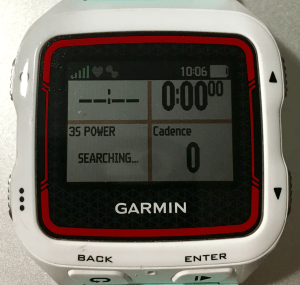
Four fields on the Garmin 920XT
Power User Tip: Continue checking your Garmin Express set up as There are many firmware updates being made (it will be under your 920) and there are even some Apps in the “Connect IQ” section that might pertain as well:
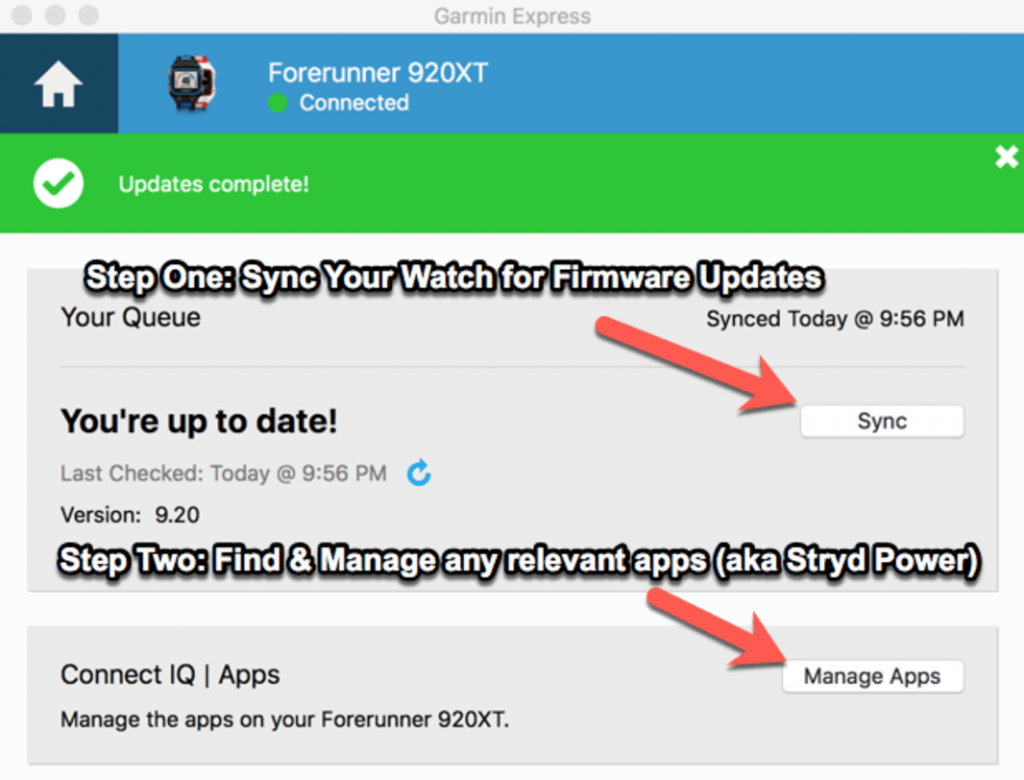
Navigating Garmin Connect IQ via Garmin Express
Step 3. Review Your Runs in the Stryd Power Center. You can Access your account in the Stryd PowerCenter here. The PowerCenter will give you insight to some basic metrics for running with power, including Avg Elapsed Power (Avg Power) and Avg Elapsed Form Power. Both are great metrics to track, however without a correlation to heart rate deep analysis isn’t possible. After all, we are not just interested in Power but also the physiological cost of that power (as expressed by Heart Rate).
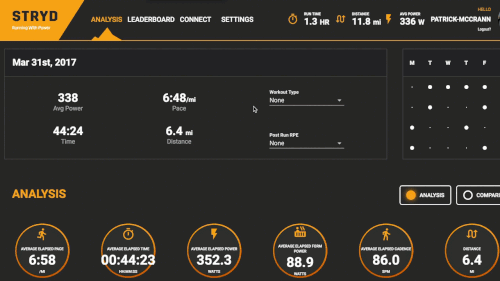
This is a good tool as some of the metrics for Stryd are proprietary and won’t be found elsewhere for a while. You can not only view individual workouts, you can compare two separate runs as well (great for repeat course runs or testing efforts).
Step 4. Optional to Purchase & Set Up Training Peaks WKO4.
Note: You might have to join their Facebook group to access the Run Dashboard, do that here.
I have WKO4 connected to my online training account for Training Peaks, so I can upload my data there To reivew and compare against all my other data. Note, this is not required to use the Stryd, as it has it’s own PowerCenter for reviewing data (see above).
This allows me to dive into some of the running data, although I am still learning about it:
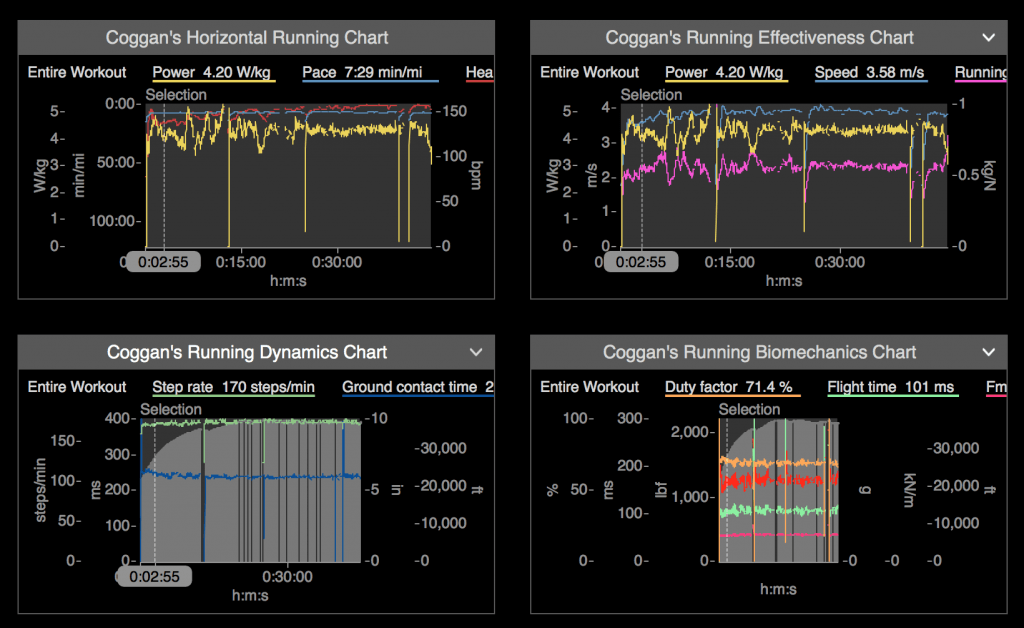
WKO4 Run Pack Screenshot
Perhaps the easiest chart to review is the Mean Maximal Power Curve that display my power output over time. This can help me identify inconsistent areas for improvement and then track my progress. As you can see from this chart I have been doing longer steady runs (the right side of the graph is “high”) and not much intensity. One modification I could make here is targeting my VO2 power at the 2 to 3 minute window.
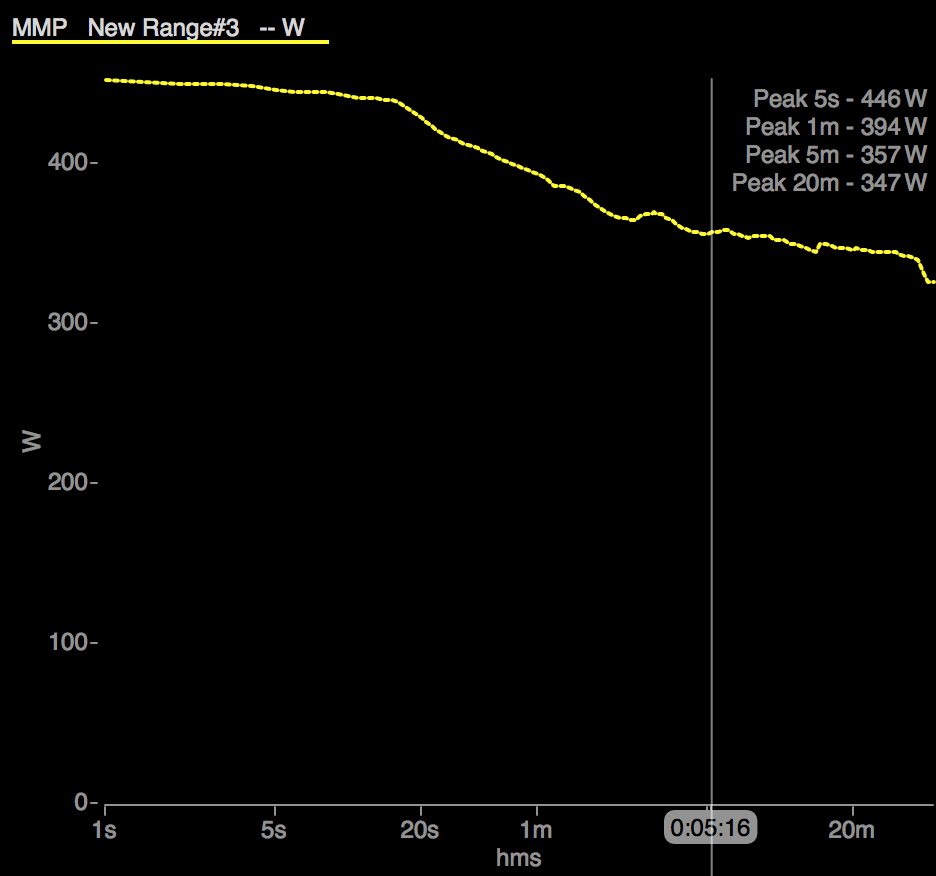
Mean Maximal Power Chart Run
Alternate Set Up
If a Garmin Watch isn’t in your future (or present!) you can use the Stryd app on your iPhone to run with. The display isn’t easy to use on the phone, but presumably you could view data on your “smartwatch” too if you had one of them.
Testing for Power Performance
There are a few recommended tests for running with power, but the baseline Endurance Nation test protocol of a 5k is just fine for what we do. After all, we don’t run at/near VO2 (Zone 5 or Zone 5+) on race day, so that number isn’t critical to us.
5k Time Trial Protocol
Run: Test
WU: 15’ including 4 x 30 secs at 5k pace.
MS: Run a 5k Time Trial. Find a relatively flat course (or track) for your test. Goal is to hold a pace you can sustain for the full duration of the test without blowing up and without having a lot left to kick at the end. Note: The ideal course is one you can test on repeatedly.
CD: Walking, jogging as needed, etc.
Additional Test Instructions for Endurance Nation Members:
For Pace: Just use the entire 5k Time in the EN Zone Calculator to lock it in, save Pace zones to your profile.
For Heart Rate: Use the Average Heart Rate for the Final 20 minutes of your test. Enter this into the EN Zone Calculator to lock it in, save Heart Rate zones to your profile.
For Power: Use the average power for the run and enter it into the temporary EN Run Power Zone Calculator. Learn more about each zone below.
Running with Power Zones
There are six critical zones for Running insde Endurance Nation. These zones initiated from the guidance of legendary running coach Jack Daniels and his vDOT approach that was the first to really quantify running before power.
For most of your Endurance Nation training, you will run according to pace and monitor for power during the run to keep you inside the same effort zone. This will happen in Zones One through Three.
When completing Zone 4 workouts (Mile Repeats) and Zone 5 workouts (VO2 intervals), we recommend that power becomes your primary focus to maintain the proper effort and derive the maximum benefit.
- Zone 1 / Long Run Pace / Easy (80% rFTPw and below): Warm Up / Go All Day pace.
- Total Run Pace / Run Durability (80% to 82% rFTPw): This is the official Run Durability Pace, and is the default run pace for Ironman® and 70.3® athletes. We build endurance here.
- Zone 2 / Marathon Pace / Steady (85% to 88% rFTPw): This is your open Marathon Pace, target 70.3® race pace. We challenge our endurance here.
- Zone 3 / Half Marathon Pace / ModHard (90% to 95% rFTPw): This is your open Half Marathon Pace, where we do most of our Tempo training. This is our Always be Pushing Zone.
- Zone 4 / Threshold Pace / Hard (100% to 105% rFTPw): This is your 10k to 5k pace; it is our default “get faster” zone. Inside Stryd, this is also known as Critical Power.
- Zone 5 / Interval Pace / Very Hard (110% rFTPw and Above): This is our 1/2 mile repeat (or shorter pace) for building VO2. These efforts are costly and need to be closely monitored.
Analyzing & Monitoring Your Runs: Now, but Slightly Better
Instead of looking at an entire run for performance, it’s now possible to extract specific data to compare for improvements. We recommend this approach as macro run data is really only best used for season planning or macro cycle changes (aka when to insert a rest period, how to taper for a race, etc).
When Using Intensity: For example, if you are doing Mile Repeats as part of your training right now, you can compare each of those miles to one another — both on the same day but also across time. In other words, you’ll be able to tell if you are faster, stronger, more efficient or tired…all from the data.
When Training Endurance: You can also compare Average Power to Heart Rate as a measure of run fitness. The fitter you get, the more efficient you should become in your training. This progress can be revealed simply by aggregating the summary data from these long runs.
When Targeting Breakthrough Performance: The last part of your race-specific workouts are the most important. Your ability to swim / bike / run with strength at the end of a critical session is an excellent benchmark of your true readiness for the race. You can now extract data from the end of a long run, for example, to compare with the end of other long runs (or even the start of that same run) to see if you are truly remaining as strong as you want to / need to be to reach your goals.
Seeking Improvement Through Your Power Meter: Future, Potentially Much Better
The biggest upside for your power meter will be improving your efficiency. We all have innate physiological limitations, but we can still do better with what we’ve got. Efficiency with your running PM is defined as getting more speed per watt.
Eventually these metrics will be easier to track and assess at a glance, letting you know if a run was better without just looking at the pace or finishing time.
Options outlined by Jim Vance include:
Type I: Increased Speed and Increased Watts
Aka You get faster and stronger simultaneously…
This is typically seen at the beginning of your training cycle as you get back into shape. You’ll get faster and stronger over the first six to eight weeks back on the path to run fitness. This can be measured by the eyeball test…you’ll see the numbers go up.
Type II: Same Speed, Same Watts, Lower Heart Rate
Aka You get aerobically efficient…
This is the second half of your General Preparation phase, when the volume doesn’t increase much / training time remains relatively static. During this phase you will see fitness gains represented as less “aerobic work” done for the same watts.
Type III: More Speed per Watt
AKA You become physiologically more efficient.
This would be seen in the compensation phase after some hard work. For example, to prepare for your next PR attempt, let’s say you added some hard interval running in to your program for six weeks. Once you are done and recovered from that phase, we would expect to see you able to run faster for your previous watts.
Type IV: Same Speed at Less Watts (measured by Efficiency Index)
AKA You become physiologically more efficient.
This is the holy grail of the fatigued endurance athlete. The ability to hold on to speed despite not being able to push more watts means finding your “running happy place” and keeping up that momentum.
You don’t have to wait until late in your season to seek this out; rather you can focus on this at any time by working on your cadence / RPMs, your running form, and even by changing out your footwear (lighter shoes anyone).
Power User Tip: Don’t Compare Every Run…have a weekly or twice monthly check in run, or a particular segment you consistently run for comparison.
Future Running with Power Gains
There are many potential upsides to having power data for the run. Here are a few that we are working on inside Endurance Nation:
Correlating Race Day rTSS With A Training Run
Rather than running for distance, now you will be able to reverse engineer runs at a shorter distance (but higher intensity) that mimic your race run. This will eliminate garbage miles and give athletes a better sense of the effort and cost associated with any particular pace. The savvy athlete will even be able to make “in race” adjustments to stay on track with their energy allocation on the run.
Importance of Tracking Data for Trends
Instead of logging time or distance per week, athletes will have a significantly more accurate representation of the Training Stress associated with any week. Remember, Training Stress is the “running load” aka fatigue that your body carries as a result of a run. Again, working off of numbers, we will be able to engineer training plans with specific run training load to be more precise and effective.
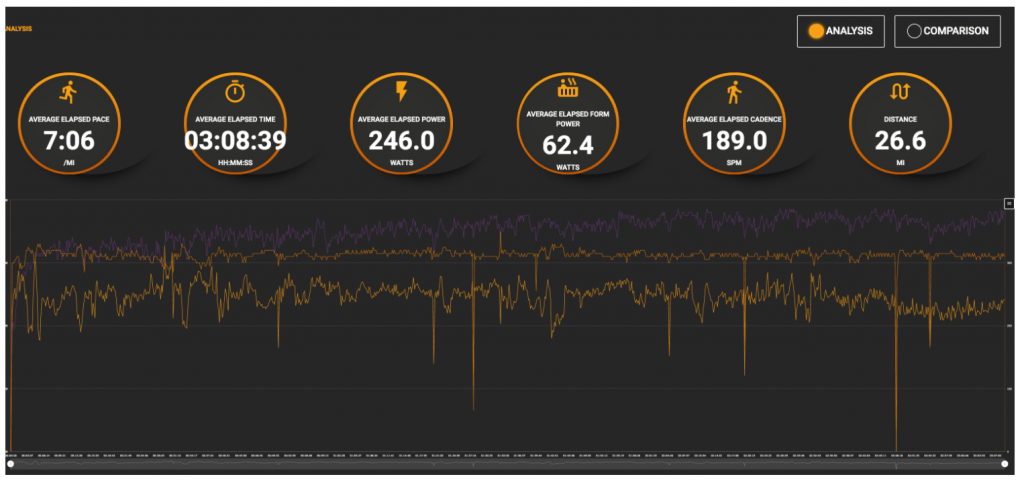
A Boston Qualifying Effort from the LA Marathon (on Stryd PowerCenter)
Better Race Day Performance Evaluation
Additional data will bring deeper insights to actual race performance. We will be able to see and quantify the events leading up to a decrease in pace — eliminating almost all post-race guesswork!
In the example image ^above^, where the bottom orange line is power, you can see this athlete did in fact “go easy” for the first few miles of this race — the power is lower. This allowed him to put in two quality consistent efforts past the halfway point that really kept him on track until the course pointed downhill at the end.
Evaluation of Non-Run Training Benefits
As metrics begin to include items such as “Leg Spring Stiffness” as a measure of running efficiency, athletes will be able to improve muscular conditioning in the gym as well as on the open road. Adding strength training isn’t a luxury, it can be a critical and quantifiable asset.
Frequently Asked Questions
What power should I use for Hill Repeats?
I don’t think you really need to track it. Hill repeats aren’t about crushing yourself as an endurance athlete, they are for improving your running form and relative strength. If anything, note your Leg Spring Stiffness over that session and in the other training sessions. If that hill training is working, you’ll see an uptick in LSS.
What about Normalized Power? It’s so critical for biking but not for running?
Basically our run paces aren’t dynamic enough to need to be normalized. Whereas you can hit 1000 watts in all our bike sprint after riding all day at 200 watts (a 5x increase!), when running we can’t put out power at such wide ranges. As such, Average Power is sufficient.
How soon should I test?
I recommend within two weeks of getting your power meter. It’s important to get everything dialed in from a display and download stand point to avoid any testing mishaps. And you’ll want to make sure to shuffle your workouts around with your coach to accommodate a proper test. Testing with your Stryd power meter will enable you to set power zones, against which you’ll be able to collect and review data on your Run Stress Score and more.
How often should I test?
Almost every Endurance Nation Training Plan has a test in the first week, and approximately every four weeks thereafter. Depending on your race, there may be more relevant benchmarking sessions than a run test…so be sure to read the fine print!
Glossary
Critical Power – Your maximal average sustainable power over one hour of running, also referred to as “lactate threshold” power; this is used as your performance baseline.
rFTPw – Run Functional Threshold Power; the metric by which you could run an hour, but no more. The linchpin for all your run power zones and predicted race performance.
rFTPa – Run Functional Threshold Pace, the effective speed created by running at your Threshold Power.
rTSS – Run Training Stress Score.



Leave a Reply